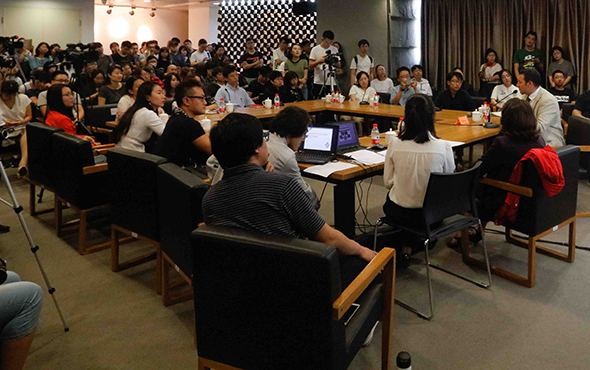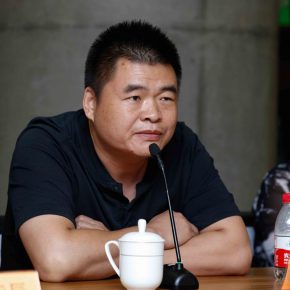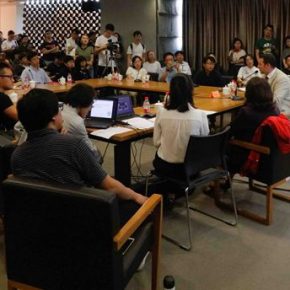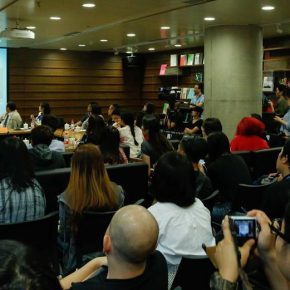
On the afternoon of September 23, a keynote speech and a seminar of “Preservation and Restoration of Italian Easel Painting” was held at the multi-functional lecture hall of the Central Academy of Fine Arts. The speaker was Mr. Emanuele Amodei, Chief Executive Officer of the Agency Palazzo Spinelli for Art Restoration and Cultural Heritage Protection, Ambassador of Florence and Member of the International Council on Monuments and Sites, as well as Gabriella Forcucci, a restorer of oil painting based on canvas and board of the Agency Palazzo Spinelli for Art Restoration and Cultural Heritage Protection.
Cao Qinghui, Deputy Director of the Library of the Central Academy of Fine Arts, Wang Yingsheng, Dean of the Institute of Restoration at the Central Academy of Fine Arts, Wang Fang, a restorer of the Institute of the Culture Heritage in China, Li Yaochen, Director of the Department of Collections at the CAFA Art Museum, Dou Tianwei, a restorer of the paper work at the CAFA Art Museum, Qu Feng, Deputy Section Chief of the Department of Science & Technology at the Place Museum, Liu Zhenghong, Deputy Director of the Original State Division at the Palace Museum, and Xu Yan, a restorer of oil painting at the CAFA Art Museum presided over the exhibition.
Emanuele Amodei: History and Development of the Institute Palazzo Spinelli for Art RestorationFirst of all, Mr. Emanuele Amodei introduced the history and development of the Institute Palazzo Spinelli for Art Restoration, and through the data to describe the situation of cultural heritage and related markets. In 1966, there was a flood in Florence, where the restorers from all over the world worked together to restore the destroyed works of art, and the records and materials have become the basic materials of the Institute Palazzo Spinelli for Art Restoration after 10 years. Agency Palazzo Spinelli for Art Restoration and Cultural Heritage Protection was established on September 26, 1976, and it is headquartered in Florence, Italy, with many branches located in Shanghai, Seoul, Tokyo, Sao Paulo, Mexico, Dubrovnik and other cities. In the past 40 years, Palazzo Spinelli has restored more than 28,000 pieces and started 8,000 courses, granting more than 60 students diplomas and degree certificates.
A sense of protection has always been kept of cultural heritage in Italy, so people themselves are living within the ancient cultural heritage rather visiting the cultural heritage sites. In 2017, there are 51 world heritage sites and 4588 museums in Italy, according to the population, each 13,000 Italians on average possess a museum and there is a museum every 100 square kilometers. The cultural heritage has created up to 68.9 billion euros in revenue for Italy. But the art market is sometimes inconsistent with the artistic value or quality, which requires the institute to have an understanding of the entire market. Cultural heritage protection and restoration will offer the market works of art with a higher quality, which is also part of the economic development of art.
Gabriella Forcucci: the Different Applications of “Complementing Color” in the each caseMs. Gabriella Forcucci is not only a restorer of oil painting based on canvas and board, but has also been a lecturer at the Palazzo Spinelli Institute since 1982. She pointed out that the purpose of restoration of cultural relics was to try their best to effectively convey the information given by the original pieces. A few centuries ago, people realized that the natural fading, incidents such as floods, human factors and improper purposes, methods, and materials applied in the process of restoration could cause damage to art, but it has never applied a more decisive form, nor a more designed method to restore the works until the last century. In 1963, Cesare Brandi, an Italian expert of cultural restoration, proposed the principles of cultural restoration: reversible, identifiable and minimal intervention. This is the mainstream view of Western cultural restoration, but these principles are often not easy to be achieved in the actual restoration.
Then, it formed a new role that is responsible for the restoration and preservation, which is different from the restorer of oil painting during the past few decades. As a technician of restoration and preservation, his job is to preserve and restore the original paintings and materials. But the restoration also means that it will remain as a trace that does not exist in the original painting. Therefore, the restorer has to limit his own intervention to the paintingas far as possible, including both the static problems related to the structural rigidity of the whole painting, and also the spread of the correct content of the original painting, while also thinks of the aesthetic issues in order to meet the needs of the language of image and commercial value. As a restorer, one should limit the artistic expression as much as possible in the process of restoration.
It is very important for the restorer to continue to study the material, using more stable material. The use of materials allows two kinds of needs so as to find a balance and a point for compromise. There are two different needs: on the one hand, it looks healthier, namely being of commercial value; on the other hand, it correctly interprets and restores the original function of the painting, which requires the intervention the painting.
Gabriella Forcucci then took some specific cases as examples to introduce several ways of complementing color: firstly, one case used the intermediate color to restore it. Secondly, the copy process, although it used the copy to complement the color, the restorer used interwoven lines to make it identifiable in order to separate it from the restoration. Thirdly, it used color selection or the system called “color abstraction” to complement color, which is a reform of the method of vertical shadow line from the last century, with the exact choice of the original color of the missing part of the painting.
In addition, she talked about some special cases, where the restorers also made some changes or reconstructions of the images of paintings. For example, in Caravaggio’s painting of “La Decollazione del Battista”, the restorer identified the brushworks to construct the previous part that had been missed and he has both repaired the missing part of blood and reconstructed the part of the signature. In another piece of work, the restorer removed the traces produced by the previous restorer. For a fresco on the ceiling, restorers also had to determine whether the remains were from the previous restoration or not: they finally maintained the original piece created in the 14th century, and removed the restoration of the baby’s clothes finished in the 16th century.
Ms. Forcucci, through the analysis of the historical background and material of the work, as well as the research of preservation, choose a responding program of restoration. Although, a series of restoration cases of Palazzo Spinelli show that the skills of complementing color are extensively applied in a variety of cases, it does not mean that it is the perfect solution so far. Ms. Gabriella Forcucci said that choosing a stable material was in the first place in the process of restoration, followed by a reversible process of the material. At the same time, it is necessary for the restorers to have an in-depth study of the history and science, to cooperate with historians, chemists, physicists, etc., to discuss and experiment with advanced materials and techniques until it is applied to the restoration.
In the follow-up seminar, the honored guests were rooted in the speeches and had a profound discussion on the materials and methods of operation used in the process of restoration. At the same time, it launched a detailed discussion on the cultural differences between China and the West with a different concept of restoration. Finally, they had a hot discussion on the phenomenon of the superposition of information of cultural relics in different historical periods.
Text by Wu Huixia, translated by Chen Peihua and edited by Sue/CAFA ART INFO
Photo by Wang Yuqi/CAFA ART INFO











































